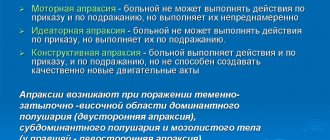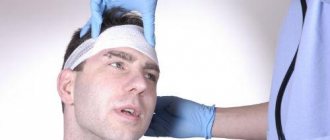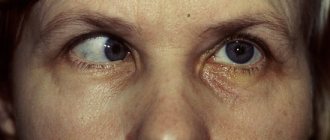Dysarthria is a complex speech disorder, one of its most common forms is bulbar. The word “dysarthria” itself comes from the Greek “dys” - “disorder” and “arthroo” - “pronounce clearly”. Bulbar dysarthria manifests itself as slurred, slurred speech with a dull nasal tone. A child with this disorder speaks as if he has porridge in his mouth.
A similar disorder occurs due to damage to the speech apparatus of the CNS (central nervous system). The first detailed description of dysarthria appeared more than a century ago. It was compiled by A. Oppenheim and H. Gutzmann. This disorder was studied in more detail in 1888 by A. Kussmaul.
Reasons for the development of bulbar dysarthria in children
The immediate cause of the defect is damage to the bulbar nerves. The glossopharyngeal nerve goes to the muscles of the pharynx, the vagus nerve goes to the palatine, pharyngeal muscles and the upper part of the respiratory tract, and the hypoglossal nerve goes to the lingual muscles.
The damaging factors are:
- Perinatal factors - complicated pregnancy, severe gestosis, abnormal fetal position, threat of miscarriage and premature birth, placental abruption, labor abnormalities, birth injuries;
- Traumatic brain injuries of any severity and form;
- Volumetric formations of the brain - tumors are accompanied by the uncontrolled growth of defective cells that penetrate all layers of the brain and destroy healthy cells, leading to compression;
- Neuroinfections - meningoencephalitis, viral encephalitis, echinococcal infection, tuberculosis lead to an inflammatory process and compression of the nuclei of the cranial nerves by the edematous medulla;
- Neurodegenerative processes destroy the nuclei of cranial nerves;
- Encephalopathy and angiopathy due to somatic diseases - diabetes mellitus, vascular abnormalities. They interfere with blood circulation in the brain.
The mechanism of development of the pathology is associated with the development of paresis in those muscle groups that innervate the damaged nerves. Their strength and tone decreases. The muscles atrophy, due to which the contractile force first weakens and then disappears completely. The soft palate droops.
Causes
Based on the fact that motor neuron disease according to ICD-10 is classified as a systemic atrophy affecting predominantly the central nervous system, its main characteristics are degenerative processes in the central gyri of the frontal lobes. The destructive process spreads to the nuclei of motor neurons of the brain stem with changes in the corticospinal tracts. The result is slowly progressive muscle atrophy.
The causes of MND include heredity and environmental factors. In familial cases of the development of pathology, mutations of individual genes encoding DNA-binding proteins are noted. The hereditary form of the pathology occurs in 5-10% of cases. In other cases, the cause of the pathology remains unknown.
Provoking factors may be:
- shock and mechanical injuries of the brain and spinal cord;
- excessive physical activity;
- exposure to harmful substances.
Currently, motor nerve disease continues to be studied. Now theories are being developed about the connection of pathology with disruption of the chemical structures of RNA, failure of transport of metabolic products in cells, and disruption of energy metabolism. Research has shown that infectious diseases such as polio do not cause motor nerve disease, although they are characterized by progressive muscle atrophy. Although the pathologies have approximately the same end result, their mechanisms of action are different.
Symptoms of bulbar dysarthria in a child
Depending on which cranial nerves are affected, the symptoms of bulbar dysarthria will vary. Sometimes a child has all the manifestations:
- Blurred, slow speech with poor articulation. Stop sounds and the sound “r” are replaced by fricative sounds. For example, instead of “b” children pronounce “v”, instead of “p” - “f”;
- There are no voiced consonants. Stressed and unstressed vowels are pronounced the same, the best result is “a”;
- The rhythm is disturbed, which is why the pronunciation is inexpressive, monotonous, without dynamism. Expressive speech is challenging;
- Swallowing disorders - choking with cough. First of all, problems arise with the intake of liquid food and drinks that flow into the nose. In the future, it becomes difficult to eat solid food;
- Voice change - decreased volume, sonority, nasality;
- Weakness of facial muscles or facial asymmetry if the nerve damage is unilateral.
Neurological symptoms are also present in bulbar dysarthria. The child may complain of headaches, dizziness, nausea not associated with food intake, paresis of an arm or leg, and gait disturbance.
There will be symptoms of bulbar dysarthria characteristic of each disease: with infection - fever, body aches, perinatal encephalopathy - delayed neuropsychic development.
Clinical picture
A characteristic sign of bulbar syndrome is deviation of the tongue towards the affected side.
Combined peripheral damage to the glossopharyngeal, vagus and hypoglossal nerves leads to paresis of the muscles of the palate, pharynx, larynx, and tongue. Characteristic is the combination of the triad “dysphonia-dysarthria-dysphagia” with paresis of half the tongue, sagging of the palatal curtain and the disappearance of the pharyngeal and palatal reflexes. Changes visible in the oropharynx are most often asymmetrical; the appearance of bilateral bulbar symptoms is a prognostically unfavorable sign.
Upon examination, deviation (deviation) of the tongue towards the lesion is revealed. Its paralyzed half becomes hypotonic and inactive, and fasciculations may appear in it. With bilateral bulbar palsy, there is almost complete immobility of the entire tongue, or glossoplegia. Due to the increasing atrophy of the paretic muscles, the affected half of the tongue gradually becomes thinner and becomes pathologically folded.
Paresis of the muscles of the soft palate leads to immobility of the palatine arches, sagging and hypotension of the palatine curtain with deviation of the uvula to the healthy side. Together with the loss of the pharyngeal reflex, disruption of the functioning of the muscles of the pharynx and epiglottis, this becomes the cause of dysphagia. There are difficulties when swallowing, choking, reflux of food and liquids into the nasal cavity and respiratory tract. Therefore, patients with bulbar syndrome have a high risk of developing aspiration pneumonia and bronchitis.
When the parasympathetic portion of the hypoglossal nerve is damaged, the autonomic innervation of the salivary glands is disrupted. The resulting increase in saliva production, together with impaired swallowing, causes drooling. Sometimes it is so pronounced that patients are forced to constantly use a scarf.
Dysphonia in bulbar syndrome is manifested by nasality, deafness and hoarseness of the voice due to paralysis of the vocal cords and paresis of the soft palate. The nasal tone of speech is called nasolalia; such nasalization of sound pronunciation can appear in the absence of obvious disorders of swallowing and choking. Dysphonia is combined with dysarthria, when slurred speech occurs due to impaired mobility of the tongue and other muscles involved in articulation. Damage to the medulla oblongata often leads to a combination of bulbar syndrome with facial nerve paresis, which also affects speech intelligibility.
With severe paralysis of the muscles of the palate, pharynx and larynx, asphyxia may occur due to mechanical blocking of the lumen of the respiratory tract. With bilateral damage to the vagus nerve (or its nuclei in the medulla oblongata), the work of the heart and respiratory system is inhibited, which is due to a violation of their parasympathetic regulation.
Differences between bulbar and pseudobulbar dysarthria
These two forms of speech disorders have many similarities. But there are signs that will help distinguish bulbar dysarthria from pseudobulbar:
- in the bulbar form of dysarthria, the paralysis is peripheral, in the pseudobulbar form - central;
- with the first type of defect, both voluntary and involuntary movements are impaired, with the second - only voluntary;
- characteristic of bulbar dysarthria is the extensiveness of motor impairments, pseudobulbar dysarthria is characterized by limited and selective pathology (complex articulatory movements suffer);
- with a bulbar lesion, the pronunciation of vowels is closer to a neutral sound, with a pseudobulbar lesion - it is moved back;
- deafening of vowels and voiced consonants, characteristic of the bulbar form of dysarthria. In addition to this, voicing occurs in the second type of disease.
Symptoms of the disease
The symptoms of pseudobulbar dysarthria depend on the severity, of which there are only four:
- 1st degree – there are no pronounced speech defects, which can be identified by a speech therapist.
- 2nd degree – the child’s speech is understandable, but some speech disorders are noticeable.
- 3rd degree – speech is incomprehensible to people around, including loved ones.
- 4th degree – the patient’s speech is not completely understandable.
The general symptoms of this form of dysarthria have some components:
- distorted syllables, sounds;
- hypertonicity of the facial muscles;
- limited mobility of the tongue and lips;
- increased salivation;
- weak quiet voice;
- arrhythmia of breathing.
A diagnosis of “pseudobulbar dysarthria” can only be made by a speech therapist or neurologist based on certain research results.
Diagnosis of bulbar dysarthria in children
The bulbar form of dysarthria is diagnosed on the basis of a neurological, speech therapy examination and data from instrumental research methods.
The stages are:
- A neurological examination can reveal the localization of bulbar dysarthria and its symptoms (dysphonia and dysphagia), as well as other signs of a neurological disease (facial asymmetry, tongue deviation, muscle atrophy, decreased reflexes). The doctor assesses the prevalence of the pathological process, makes an accurate diagnosis and determines the severity. At this stage, it is important to study the medical history: the course of pregnancy and childbirth, features of early development, previous diseases and injuries;
- Examination by a speech therapist - assessment of voice, speed, rhythm of speech, mobility and coordination of articulatory muscles, the state of facial muscles and breathing. The specialist identifies the characteristics of bulbar dysarthria and determines treatment tactics;
- CT, MRI, electroencephalography, ultrasound, Dopplerography provide information about vascular disorders, organic pathology, space-occupying formations, inflammatory process, degenerative pathology;
- Lumbar puncture is needed to identify the causative agent, therefore it is performed if the infectious-inflammatory nature of the pathology is suspected.
If necessary, the child may be referred for additional research methods and for consultation with other doctors.
Doctors are faced with the task of differentiating the bulbar form of dysarthria from pseudobulbar syndrome, which is caused by damage to the corticobulbar tracts. It is also necessary to exclude motor, acoustic-mnestic and dynamic aphasia.
Treatment
It is not the bulbar syndrome itself that requires treatment, but the underlying disease and the resulting life-threatening conditions. If the severity of symptoms increases and signs of cardiac and respiratory failure appear, the patient requires transfer to the intensive care unit. According to indications, mechanical ventilation is performed and a nasogastric tube is installed.
To correct disorders, in addition to etiotropic therapy, drugs of various groups with neurotrophic, neuroprotective, metabolic, and vascular effects are prescribed. Hypersalivation can be reduced with atropine. During the recovery period or for chronic diseases, massage, classes with a speech therapist, and kinesiotherapy are prescribed to improve speech and swallowing.
Bulbar syndrome is a serious sign of damage to the medulla oblongata. Its appearance requires a mandatory visit to a doctor to clarify the etiology and decide on the need for hospitalization.
Petrov K. B., MD, professor, brings to your attention a slide show about clinical variants of bulbar syndrome and non-drug methods of treating this condition:
Treatment and correction of bulbar dysarthria in children
Treatment of the pathology is complex, aimed at the cause, as well as the symptoms of bulbar dysarthria. Treatment of neurological diseases and speech disorders is carried out, which is consolidated by a rehabilitation program.
Neurological help is to eliminate the cause of the disorders. If an infectious-inflammatory process occurs, antibacterial or antiviral drugs and infusion therapy are used. In case of space-occupying formations, surgery followed by a rehabilitation program is indicated.
It is also necessary to restore brain cells. Neurometabolic therapy is used for this: nootropics, neuroprotectors, vitamins.
Speech therapy assistance is aimed at eliminating the external characteristics of bulbar dysarthria. A speech therapist helps develop articulatory muscles, get rid of speech defects, establish the correct pronunciation of sounds, and make speech smooth and expressive. Massage, exercises, and breathing exercises are used. Let us remind you that the effect of speech therapy will be zero if the cause is not eliminated.
The rehabilitation program is carried out through general massage, physiotherapist, physical therapy, swimming. You may need help from a psychologist.
Parents should be aware that treatment is usually long-term: it may take more than one month until speech returns to normal. Therefore, you need to be patient and persistent.
Motor Neuron Disease: Types
Motor neuron disease has ICD-10 code G12: Spinal muscular atrophy and related syndromes. It belongs to a group of neurological diseases in which motor neurons are damaged. Synonyms: Lou Gehrig's disease, Charcot's disease. In many countries, it is customary to use the term “amyotrophic lateral sclerosis” (ALS) to refer to motor neuron disease, as the most common pathology in this group. This also includes:
- hereditary spastic paraplegia;
- primary lateral sclerosis;
- progressive muscle atrophy;
- motor neuron disease, bulbar form;
- pseudobulbar palsy;
- primary lateral sclerosis.
The disease is characterized by degeneration of motor neurons in the cerebral cortex, brain stem, corticospinal tracts and spinal cord. The result is progressive muscle paralysis.
The disease is rare. Its prevalence is approximately 2-3 people per 100 thousand per year. Most often, the disease occurs in people aged 60-70 years, although it is possible that the pathology may develop in people under 40 years of age.










